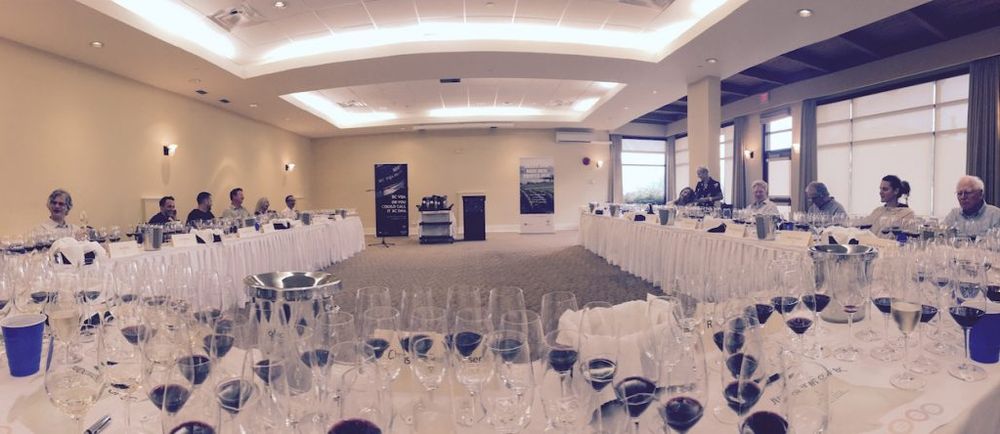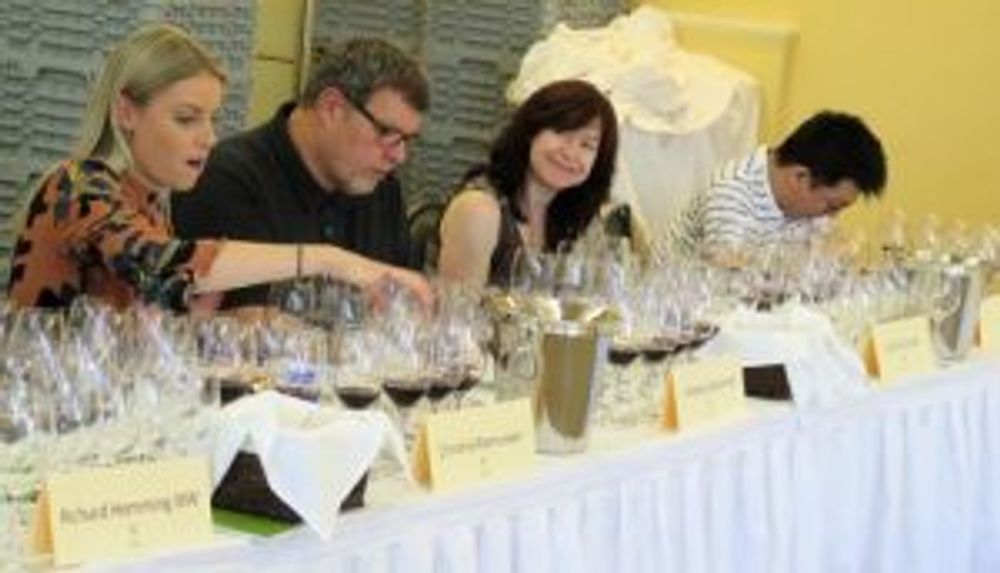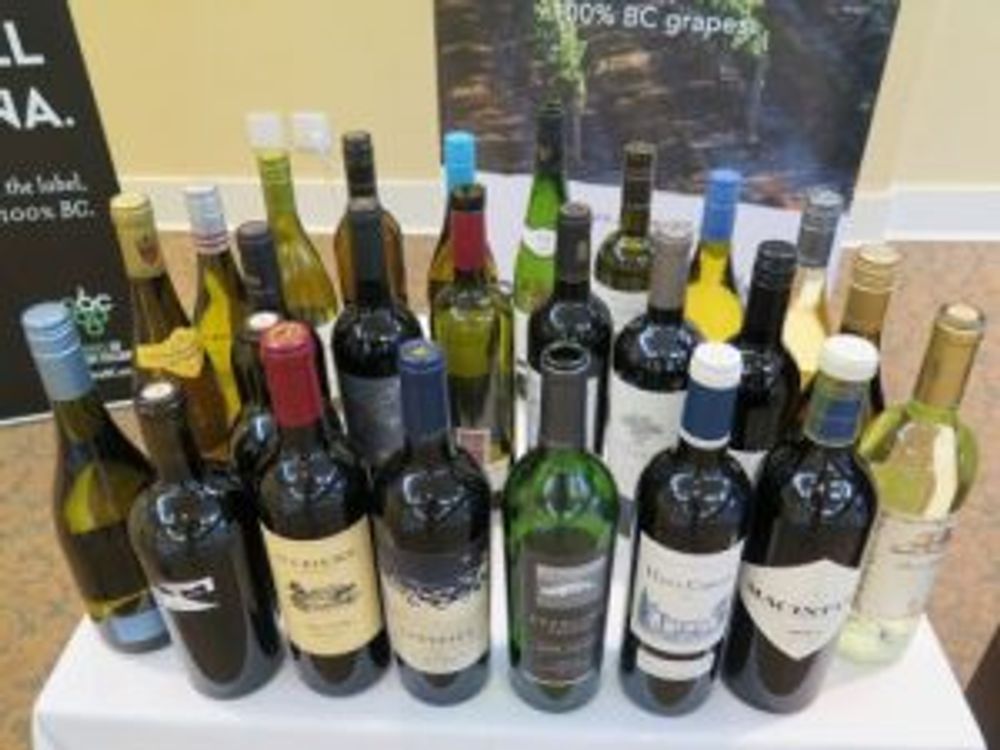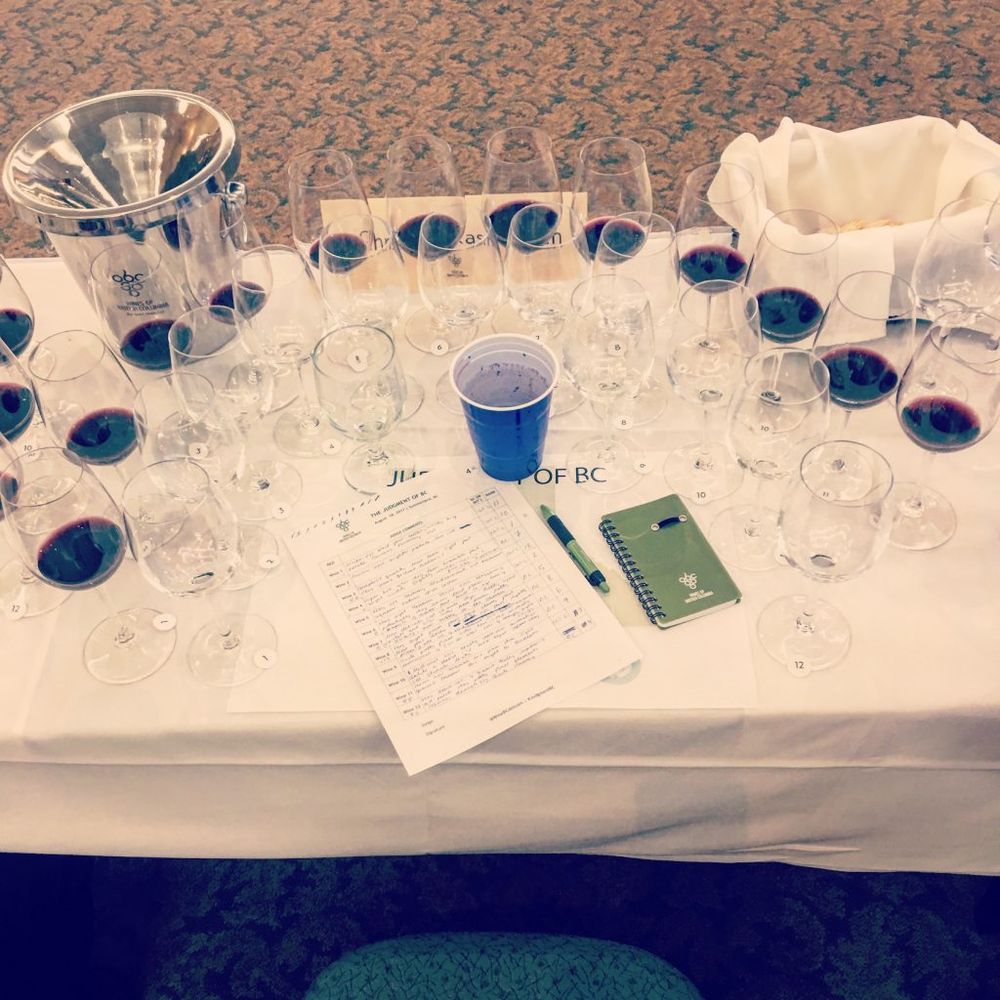In the Merlot category a wine from British Columbia, CheckMate Black Rook Merlot 2013, was ranked first above wines from California, Bordeaux and Chile, while in the Pinot Gris category the BC wines took third, fifth and sixth place.
The Judgment of BC is an initiative that was, of course, inspired by Steven Spurrier’s The Judgment of Paris, which, in 1976 changed the wine world in a major way and helped shape the growth and importance of New World wines. Naturally enough, Spurrier was present at the first Judgment of BC, which examined Chardonnay and Syrah.

This year, the third annual Judgment of BC, looked into the two most widely planted grape varieties of British Columbia: Pinot Gris and Merlot. The tasting was hosted by the BC Wine Institute, and curated by DJ Kearney, a Vancouver-based wine expert and director of wine at new district.ca
The blind tasting commenced with Pinot Gris. I didn’t know what to expect here, as Pinot Gris is so immensely diverse as a grape variety, and on an international scale of course planted in the majority of major wine regions on all sorts of soils and in all sorts of climates.

Christina Rasmussen (far left)
It is, for me, highly susceptible to expressing winemaking decisions, so immediately the questions of “Innoculation or native yeasts? Reduction? Extraction? Skins?” coursed through my mind. Furthermore, of course there is the question of sugar: dry and off dry examples were both shown.
Putting my nose to the test, I went about sniffing and swirling 12 examples of what was a myriad rainbow of Pinot Gris. It was really fun. All too often in the wine trade we forget to mention how fun this is, and how extremely exciting it is. Sitting in front of me were six BC wines in the mix whose vines would quite simply not exist were it not for such a pioneering and dynamic group of winemakers, and of course six wines from further afield, all deemed exemplary of the grape variety by Kearney. It was my job to assess them all fairly.
My notes and opinions on the wines appear at the end of this article, in the order I ranked them, and with the number they were ranked as a “general consensus” number.
The tasting notes are short; I was mainly trying to discern my ordering and the origin, so do excuse the lack of description.

The results…
I found the Pinot Gris flight fascinating, although difficult to judge due to stylistic factors. Some were made reductively, some more fruit-forward and, of course, to throw the spanner into the works, two were sweet styles. They were all of good quality, and BC fared well for me. I was pleased to see Haywire in there, and recognised it. I think this is a really good wine, and I love its textural element. I placed it first for this reason. It is made in a more reductive style, but the tightness dissipates with a good swirl and out comes a stunning mineral salinity and for me, the length was the real pick me factor. The wine continued forever in the glass.
My second wine was Zind Humbrecht’s wine, which is a brilliant wine. Comparing these two wines is very difficult and actually I would put them joint first, if that was possible. I think perhaps judging sweet wines with dry wines is too difficult, and I would maybe have created two panels – one sweet, and one dry, or two flights perhaps.
The other BC wines were all fresh and stylistically clean, pretty and lifted. Meanwhile, from New Zealand, Kim Crawford’s wine was voted number one by the panel as a whole. For me, while it expressed good minerality, the fruit sensation and expression on the palate gave me too much of an indication of what I would perceive to be cool fermentation and possibly non-indigenous yeast for it to really excite me, thus I placed it 5th.
Meanwhile, Merlot was very mixed in terms of results for me with, for example, Bordeaux finishing first and last, and British Columbia sitting comfortably in the middle, with my top BC wine being La Stella Maestoso 2012 by the very talented Severine Pinte, a striking wine that I really admire, which came in at 4th. Judging this was very difficult, and I think the first placed wine reflected a very classical and well managed style, as well as in second place the wine had a more ‘out there’ style with lots of freshness, something that is often lost in examples of Merlot. I found it refreshing.

I think the quality overall was very high for the Merlots and it is clear that British Columbia has a strong future for Merlot. However, I feel that Merlot is often subject to a lot of intense human choices and winemaking decisions which can, for lack of better phrasing, sometimes get in the way a little for terroir. It can make great wine, of course; we are capable of achieving something striking and comforting in the glass, but for me it tends to be less about where the wines came from, and more about managing picking times, managing tannin and managing oak. A lot of ‘managing’ comes into play.
Generally speaking I did OK at ascertaining which wines hailed from BC – there tends to be a lifted acidity and a certain purity running through the fruit which I really enjoy, and think this is a common theme through BC wines.
Brilliant exercise
It was a brilliant exercise and I was thrilled to take part in it. I look forward to following results every year and also look forward to seeing what is chosen next year as a subject. Chardonnay, Syrah, Riesling, Pinot Noir, Merlot and Pinot Gris have now each been centre stage at one point or another.
So what’s next? I’d love to see Gamay, but perhaps in a couple of years’ time when there are more examples. I’m certain BC has strong potential for Gamay. I think Viognier could be considered, as well as Sauvignon Blanc, as there are strong terroir-expressive examples of the latter coming from Bench 1775 and Haywire. Sparkling could also be of interest, but once again we enter the difficulties of stylistic choices, for example petnat versus traditional method. There would need to be some definition here.
Tasting notes are below, ranked in my ordering with ‘general consensus’ and my guess as to the origin of the wines.

Pinot Gris
1
Reductive, smoky nose, with a saline mid-palate and an impressive lees-y length. This will age well. Pithy texture, dry and gunflinty. Impressed. Haywire?
I guessed BC.
General consensus placed it in 10th place.
The wine was Haywire Switchback 2015, Okanagan Valley, BC, 13.6%, $26.99
2
Pretty, floral, honeyed nose. Lovely fruit on the palate and a lees-y length.
I guessed International.
General consensus placed it in 2nd place.
The wine was Domaine Zind Humbrecht Pinot Gris Turkheim 2014, Alsace, France, 13%, $41.00
3
Lemon pith and lemon pip on the nose. Mineral, with a nice length. Saline, zippy acidity. Nice liveliness.
I guessed BC.
General consensus placed it in 9th place.
The wine was Blue Grouse Estate Pinot Gris 2016, Vancouver Island, BC, 13.5%, $22.00
4
Opulent apple and peach flesh on the nose. Less searing acidity, with pear flesh and pretty fruit. Nutmeg. Nice lees-y approach.
I guessed International.
General consensus placed it in 11th place.
The wine was Poplar Grove Pinot Gris 2016, Okanagan Valley, BC, 13.1%, $16.99
5
Green apple, super zingy. Green apple skin, striking minerality. New Zealand? Reminiscent of NZ. Apple flesh and peach flesh on palate. Nice finish. New World.
I guessed International.
General consensus placed it in 1st place.
The wine was Kim Crawford Pinot Gris 2016, Marlborough, New Zealand, 13%, $19.49
6
Bright lemon nose, with richer apple shining through. Bright palate, very direct, nice subtly mineral mid-palate. Fruity and approachable.
I guessed BC.
General consensus placed it in 6th place.
The wine was Arrowleaf Cellars Pinot Gris 2016, Okanagan Valley, BC, 13.99%, $20.99
7
Nutmeg nose. Orange peel. Less acidity. Falls a little short. Baking spice.
I guessed International.
General consensus placed it in 5th place.
The wine was Gray Monk Pinot Gris 2015, Okanagan Valley, BC, 13.4%, $16.99
8
Also more reductive in style. Zippy. Interesting palate – grapefruit pith, bright shiny acidity. Some sort of melon – honeydew perhaps? Grapefruit finish.
I guessed BC.
General consensus placed it in 4th place.
The wine was King Estates Pinot Gris 2015 Willamette Valley, Oregon, 13.5%, $26.49
9
Honeyed. Apricot, tropical fruit, peach. Botrytis? Nice peach on the palate but does fall a little short.
I guessed International.
General consensus placed it in 7th place.
The wine was Pfaff Steinert Grand Cru Pinot Gris 2012, Alsace, France, 13.5%, $30.99
10
Gunflint. Bright acidity. Nice leesy mid palate. Grapefruit pith and pip.
General consensus placed it in 3rd place.
I guessed International.
The wine was 50th Parallel Pinot Gris 2016, Okanagan Valley, BC, 13.5%, $19.99
11
Fairly quiet on the nose, but interesting on the mid-palate. Nice chalky mineral length, interesting sherbet-like mid palate. Nice salinity.
I guessed BC.
General consensus placed it in 8th place.
The wine was Alois Lageder Pinot Grigio Vigneti del Dolomiti IGT 2015, Italy, 12.5%, $25.99
12
More restrained lemon pith nose, searing acidity on mid palate, chalky texture. A little more simple in style.
I guessed BC.
General consensus placed this in 12th place.
The wine was Santa Margarita Pinot Grigio Valdadige DOC 2016, Italy, 12.5%, $19.99
Merlot
1
Graphite quality. More lean, tight fruit. Very young. Brilliant. Bordeaux?
I guessed International.
General consensus placed this in 11th place.
The wine was Château de Ferrand 2011, Saint-Emilion Grand Cru, Bordeaux, France, 14%, $51.99
2
Very reminiscent of granite? Really impressive mid-palate. Very pretty floral elements. Delicious drinkability, quite stunning.
I guessed BC.
General consensus placed this in 10th place.
The wine was Charles Smith, The Velvet Devil Merlot 2015, Washington State, 13.5%, $19.99.
3
Serious nose. Bramble and plum skin. Tight grained tannins, this could be Bordeaux…
I guessed International.
General consensus placed this in 2nd place.
The wine was Duckhorn Vineyards Merlot 2013, Napa Valley, California, 14.5%, $63.99
4
Quite a closed nose, very young and potentially very serious. Lead pencil, loads of graphite. Very tight tannins. Bramble fruit. Built to age.
I guessed International.
General consensus placed this in 3rd place.
The wine was La Stella Maestro 2012, Okanagan Valley, BC, 14.6%, $90.00
5
More delicate, cooler climate style? Pretty lifted violets and lilac notes. Fresh plums, pretty acidity, more subtle on the tannin.
I guessed BC.
General consensus placed this in 4th place.
The wine was Sterling Merlot 2013, Napa Valley, California, 14.2%, $29.99
6
Quite pretty floral notes here, lifted aromatics. Lots of energy, bright and zingy. Reminiscent of Clos du Soleil.
I guessed BC.
General consensus placed this in 1st place.
The wine was CheckMate Black Rook Merlot 2013, Okanagan Valley, BC, 14.4%, $85.00
7
Cigar box. Also lean. Bramble fruit. Bright acidity. Slightly underripe fruit notes – in a good way. Zippy acidity.
I guessed BC.
General consensus placed this in 12th place.
The wine was Culmina Merlot 2014, Golden Mile Bench, Okanagan Valley, BC, 14%, $35.00
8
Very bright plum fruit and cherry flesh. More fruit-driven. A lot of ripe fruit, some prune notes here. Lots of blackcurrant juice notes. Cedar wood finish.
I guessed BC.
General consensus placed this in 8th place.
The wine was Burrowing Owl Merlot 2014, Okanagan Valley, BC, 14.8%, $30.00.
9
Medicinal nose, unusual aromatics, quite unlike a Merlot I’ve tried before, it seems very cool climate and minty.
I guessed BC.
General consensus placed this in 6th place.
The wine was McIntyre Heritage Reserve Merlot Ardua 2012, Okanagan Valley, BC, 15.5%, $80.00.
10
Fruity nose and a bright palate. Less oak.
I guessed International.
General consensus placed this in 9th place.
The wine was Intersection Merlot Silica 2013, Okanagan Valley, BC, 14.8%, $29.00.
11
Mocha, ripe black fruit, cedar, woody, big palate. Savoury. Plummy. Hot.
I guessed International.
General consensus placed this in 7th place.
The wine was Casa Lapostolle Cuvée Alexandre Apalta Vineyard 2012, Colchagua, Chile, 14.5%, $33.99.
12
Very ripe. Jammy. Blackcurrant. Blackcurrant liqueur, baking spice and cedar.
I guessed International.
General consensus placed this in 5th place.
The wine was Château Haut Carles 2010, Fronsac, Bordeaux, France, 15%, $64.99.










































